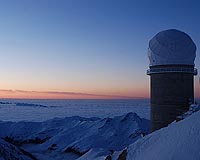 |
Mississauga, Canada (SPX) Jul 03, 2009 Microsat Systems Canada is delighted to announce the sixth birthday of the MOST Microsatellite - Canada's First Space Telescope. The MOST (Microvariability and Oscillations of Stars) microsatellite was launched June 30, 2003 from the Plesetsk Cosmodrome with a 12-month mission to study the vibration of distant stars and draw inferences about their hidden composition - a technique called asteroseismology. Although just six years old and entering Grade One in human terms, MOST, nicknamed the "Humble Space Telescope" by its creators, has actually been the source of numerous post doctorate level studies from scientists around the world for years as it continues to deliver startling results to the astronomic community concerning the makeup and origins of the universe. From its modest original goal of studying distant stars, Dr Jaymie Matthews, MOST Mission Scientist, and his global team of scientists have extended the capabilities of MOST to explore exoplanets - alien worlds around other stars - to try to shed light on the timeless question - are we alone in the universe? MOST is gathering evidence on the existence of earth-like planets around these stars, a feat not possible from even the largest earth-bound telescopes. Although well into middle age for a microsatellite, MOST continues to exceed performance specifications. The MSCI MOST operations team constantly monitors the health of the spacecraft. Operational adjustments are made from the MSCI facilities in Mississauga Canada to counter the inevitable degradation from the harsh environment of space. Dr. James Wells, head of MSCI Systems Engineering and lead engineer on MOST, observes that "along with the scientific data, we are extracting a wealth of operations data enabling us to track every facet of spacecraft performance - key information that we are using to improve the design of NEOSSat, our current microsatellite program." "As well as its immense contribution to the world body of astronomic knowledge, MOST is an unbelievable engineering resource to the NEOSSat team," says David R Cooper, President and CEO, MSCI. "I know of no other team that has an operational spacecraft to leverage its design expertise. Where others have to rely on simulations and models, we have a live test-bed. This enables us to tailor our designs and product assurance approach, especially in the area of radiation tolerance, to real, not hypothetical conditions. This brings tremendous value to our customers as it reduces our development time and costs." Share This Article With Planet Earth
Related Links MSCI Space Telescope News and Technology at Skynightly.com
 Magnetic Field On Bright Star Vega
Magnetic Field On Bright Star VegaParis, France (SPX) Jun 25, 2009 Astronomy and Astrophysics is publishing the first detection of a magnetic field on the star Vega, one of the brightest stars in the sky. Using the high-sensitivity NARVAL spectropolarimeter installed at the Bernard-Lyot telescope (Pic du Midi Observatory, France), a team of astronomers detected the effect of a magnetic field (known as the Zeeman effect) in the light emitted by Vega. ... read more |
|
| The content herein, unless otherwise known to be public domain, are Copyright 1995-2009 - SpaceDaily. AFP and UPI Wire Stories are copyright Agence France-Presse and United Press International. ESA Portal Reports are copyright European Space Agency. All NASA sourced material is public domain. Additional copyrights may apply in whole or part to other bona fide parties. Advertising does not imply endorsement,agreement or approval of any opinions, statements or information provided by SpaceDaily on any Web page published or hosted by SpaceDaily. Privacy Statement |